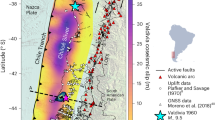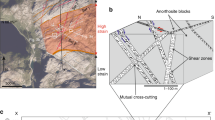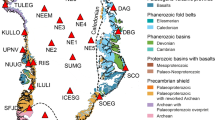Abstract
Large earthquakes change the distribution of stress in the crust, leading to aftershocks and triggered earthquakes. Several time-dependent processes, such as the flow of pore fluid1, post-seismic slip (also termed afterslip)2,3 and viscous relaxation of the lower crust and upper mantle4,5 may further alter the state of stress in the crust and thereby influence the occurrence of future earthquakes. However, distinguishing between these processes on the basis of field observations has prove to be difficult because models of the different processes can predict similar ground displacements and multiple processes may be acting concurrently6,7,8. Here, I compare results of time-series analysis of satellite radar interferograms and modelling calculations to show that multi-year ground movements following two magnitude 6.5 earthquakes in southwest Iceland were most likely driven by viscous relaxation. Viscoelastic models of a strong lower crust and a weak upper mantle can explain the magnitude as well as the pattern of the deformation, whereas afterslip models are by themselves not compatible with the observations. These results suggest that afterslip—which is an important process on mature faults2,3—may not play as significant a role in young and immature fault zones.
This is a preview of subscription content, access via your institution
Access options
Subscribe to this journal
Receive 12 print issues and online access
$259.00 per year
only $21.58 per issue
Buy this article
- Purchase on Springer Link
- Instant access to full article PDF
Prices may be subject to local taxes which are calculated during checkout


Similar content being viewed by others
References
Peltzer, G., Rosen, P., Rogez, F. & Hudnut, K. Poro-elastic rebound along the Landers 1992 earthquake surface rupture. J. Geophys. Res. 103, 30131–30145 (1998).
Bürgmann, R. et al. Time-space variable afterslip on and deep below the Izmit earthquake rupture. Bull. Seismol. Soc. Am. 92, 126–137 (2002).
Freed, A. M. Afterslip (and only afterslip) following the 2004 Parkfield, California, earthquake. Geophys. Res. Lett. 34, L06312 (1997).
Pollitz, F. F., Wicks, C. & Thatcher, W. Mantle flow beneath a continental strike-slip fault: post-seismic deformation after the 1999 Hector Mine earthquake. Science 293, 1814–1818 (2001).
Freed, A. M. & Lin, J. Delayed triggering of the 1999 Hector Mine earthquake by viscoelastic stress transfer. Nature 411, 180–183 (2001).
Hearn, E. H. What can GPS tell us about the dynamics of postseismic deformation? Geophys. J. Int. 155, 753–777 (2003).
Fialko, Y. Evidence of fluid-filled upper crust from observations of postseismic deformation due to the 1992 Mw7.3 Landers earthquake. J. Geophys. Res. 109, B0841 (2004).
Freed, A. M., Bürgmann, R., Calais, E., Freymueller, J. & Hreinsdóttir, S. Implications of deformation following the 2002 Denali, Alaska, earthquake for postseismic relaxation processes and lithospheric rehology. J. Geophys. Res. 111, B01401 (2006).
Sigmundsson, F., Einarsson, P., Bilham, R. & Sturkell, E. Rift-transform kinematics in south Iceland: Deformation from Global Positioning System measurements, 1986 and 1992. J. Geophys. Res. 100, 6235–6248 (1995).
Árnadóttir, T., Jiang, W., Feigl, K. L., Geirsson, H. & Sturkell, E. Kinematic models of plate boundary deformation in southwest Iceland derived from GPS observations. J. Geophys. Res. 111, B07402 (2006).
Einarsson, P. Earthquakes and present-day tectonism in Iceland. Tectonophysics 189, 261–279 (1991).
Pedersen, R., Jónsson, S., Árnadóttir, T., Sigmundsson, F. & Feigl, K. Fault slip distribution of two Mw=6.5 earthquakes in Southern Iceland estimated from joint inversion of InSAR and GPS measurements. Earth Planet. Sci. Lett. 213, 487–502 (2003).
Jónsson, S., Segall, P., Pedersen, R. & Björnsson, G. Post-earthquake ground movements correlated to pore-pressure transients. Nature 424, 179–183 (2003).
Árnadóttir, T., Jónsson, S., Pollitz, F. F., Jiang, W. & Feigl, K. L. Postseismic deformation following the June 2000 earthquake sequence in the south Iceland seismic zone. J. Geophys. Res. 110, B12308 (2005).
Savage, J. C. & Svarc, J. L. Postseismic deformation associated with the 1992 Mw7.3 Landers earthquake, southern California. J. Geophys. Res. 102, 7565–7577 (1997).
Deng, J., Gurnis, M., Kanamori, H. & Hauksson, E. Viscoelastic flow in the lower crust after the 1992 Landers, California earthquake. Science 282, 1689–1692 (1998).
Berardino, P., Fornaro, G., Lanari, R. & Sansosti, E. A new algorithm for surface deformation monitoring based on small baseline differential SAR interferograms. IEEE Trans. Geosci. Remote Sensing 40, 2375–2383 (2002).
Pollitz, F. F. Gravitational-viscoelastic postseismic relaxation on a layered spherical Earth. J. Geophys. Res. 102, 17921–17941 (1997).
Stefánsson, R. et al. Earthquake prediction research in the south Iceland seismic zone and the SIL project. Bull. Seismol. Soc. Am. 83, 696–716 (1993).
Bjarnason, I. T., Menke, W., Flóvenz, Ó. G. & Caress, D. Tomographic image of the mid-Atlantic plate boundary in southwestern Iceland. J. Geophys. Res. 98, 6607–6622 (1993).
Pollitz, F. F. & Sacks, I. S. Viscosity structure beneath northeast Iceland. J. Geophys. Res. 101, 17771–17793 (1996).
Johnson, K. M., Bürgmann, R. & Larson, K. Frictional properties on the San Andreas fault near Parkfield, California, inferred from models of afterslip following the 2004 earthquake. Bull. Seismol. Soc. Am. 96, S321–S338 (2006).
Johanson, I. A., Fielding, E. J., Rolandone, F. & Bürgmann, R. Coseismic and postseismic slip of the 2004 Parkfield earthquake from space-geodetic data. Bull. Seismol. Soc. Am. 96, S269–S282 (2006).
Townend, J. & Zoback, M. D. Regional tectonic stress near the San Andreas fault in central and southern California. Geophys. Res. Lett. 31, L15S11 (2004).
Clifton, A. & Einarsson, P. Styles of surface rupture accompanying the June 17 and 21, 2000 earthquakes in the Southern Iceland Seismic Zone. Tectonophysics 396, 141–159 (2005).
Acknowledgements
I thank T. Árnadóttir for discussions and for providing GPS data14 and J. Hoffmann for his contribution during the early phase of this work. This project was funded by the Icelandic Centre of Research. The radar data were provided by the European Space Agency through Category-1 project No. 3846.
Author information
Authors and Affiliations
Corresponding author
Supplementary information
Supplementary Information
Supplementary figures S1-S4 (PDF 1970 kb)
Rights and permissions
About this article
Cite this article
Jónsson, S. Importance of post-seismic viscous relaxation in southern Iceland. Nature Geosci 1, 136–139 (2008). https://doi.org/10.1038/ngeo105
Received:
Accepted:
Published:
Issue Date:
DOI: https://doi.org/10.1038/ngeo105
This article is cited by
-
Power-law rheology controls aftershock triggering and decay
Scientific Reports (2016)



